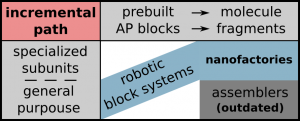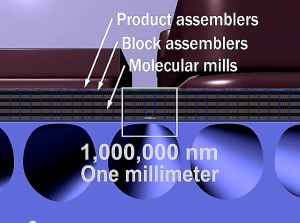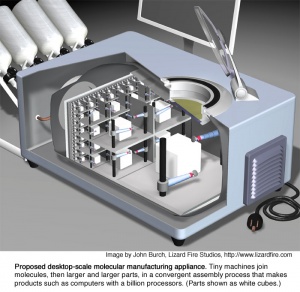Difference between revisions of "Gem-gum technology"
(→Vacuum) |
m (→Vacuum) |
||
| Line 99: | Line 99: | ||
At some place in the [[assembly levels]] (above Level II) '''products''' or fractions of them '''need to be locked out''' out of the vacuum area while keeping the interior perfectly gas free. This can be done with two pistons the like depicted below. | At some place in the [[assembly levels]] (above Level II) '''products''' or fractions of them '''need to be locked out''' out of the vacuum area while keeping the interior perfectly gas free. This can be done with two pistons the like depicted below. | ||
| − | This method doubles as a pump for stray gas molecules. | + | This method doubles as a pump for stray gas molecules. Import of parts (locking them in) is not possible here. |
[[File:Single-cycle-export-airlock.png|A method to lock out passivated parts into non-vacuum-areas that keeps the internal vacuum completely intact. Only export of parts is possible here. To import parts for tuning/repair/recycling an other method has to be used.]] | [[File:Single-cycle-export-airlock.png|A method to lock out passivated parts into non-vacuum-areas that keeps the internal vacuum completely intact. Only export of parts is possible here. To import parts for tuning/repair/recycling an other method has to be used.]] | ||
Revision as of 13:01, 22 December 2013
The kind of products in this technology level are outlined in the definition of APM on the Main Page.
This page should give more details to the different aspects of advanced APM systems.
previous: technology level II
next: further improvement at technology level III
Contents
Productive nanosystems
In the beginning of APM research only (molecular) assemblers where considered as a means for reachig the capability to produce macroscopic amounts of a product.
At T.Level III it turns out that Advanced nanofactories are more balanced and efficient than Assembler systems. At technology level I the border between minimal assemblers and rudimentary nanofactories is more blurred. FAULTY! TO REPAIR! A rudimentary nanofactory might be buildabel without self replicon but a simplified two dimentional assembler model might work well too.
To have an umbrella term for both ideas The term productive nanosystems was introduced.
Using the whole volume for the building process of the product rather than a layer in the "classic" nanofactory design could speed up the building process. But this will not be neccesary for practical usage [TODO find existing proof]. If you build a solid block though you might end up to being slower than with the layer method due to the fractal growth speedup limit
Assembly levels
The assambly process of AP products can be clearly divided in a number of subsequent steps no matter whether the concrete implementetion of a productive nanosytem looks more like a nanofactory or more like an assembler system. Those steps are implementation agnostic. Further details can de found on the assembly levels page.
Assemblers
Note: Assemblers are deprecated!
The idea is to create a machine with side-lengths of a few hundred nanometers which packages all the functionality to produce useful products and also make copies of itself (directly with diamondoid mechanosynthesis). This way you get an exponential rate of reproduction and can produce macroscopic goods in reasonable amounts of time.
It turned out that packaging all the functionality into such a small package is a rather unbalanced and inefficient approach for T.Level III. This can be seen in the nanofactory cross section image (further down this page) where it is visible that the bottommost assembly levels (here layers) take the largest portion of the stack. In the small package of an assembler the bottommost layers would be underrepresented making it rather slow.
Quite a bit of thought was put into this model. Either they where supposed to swim about in a solution or there was some form of movement mechanism in a machine phase scaffold crystal envisioned like:
- sliding cubes [TODO add references]
- legged blocks [TODO add references]
The combination of their appearance (legs) with their very tightly packed capability of self replication in their vacuum "belly" that seem akin to a "whomb" led to the situation that the public started to perceive this technology as swarms of tiny life like nano-bugs that could potentially start uncontrollable and unstoppable self replication. Why this is a rather missinformed opinion can be read up here.
Many considerations about assemblers are still relevant:
- methods for movement e.g. for the transport of microcomponents and self repair by microcomponent replacement in the higher assembly levels of nanofactories. The legged block mobility design is also known from the concept of Utility Fog (speculativity warning) but has other design priorities in an manufacturing context like more rigidity and less "intelligence".
- methods for gas tight sealing
- and many more ...
Advanced nanofactories
An artistic depiction of a nanofactory.
Note that only assemly level IV (convergent assembly) is visible in this picture.
The official productive nanosystem video [1] shows all the other assembly levels except IV.
Design levels
APM systems can depending on the size of the chunk of them that is under considereration be designed at three different levels:
- atomistic level
- lower bulk limit
- system level
Further details can de found on the design levels page.
Diamondoid Molecular Elements (DMEs)
At the core an advanced productive APM systems consist out of DMEs.
DMEs can be designed either directly at the atomistic level or in lower bulk limit form.
There are two types of DMEs:
- Diamondoid Molecular machine elements DMMEs
- Diamondoid Molecular structural elements DMSEs
Furthere details can be found diamondoid molecular elements page.
Certain standard sets like housing components or a minimal set of compatible DMMEs are needed.
Potential structural and machine elements that seem suitable to port them to DME designs can be found here:
- Thingiverse collection I
- [Todo: add further resources]
Depending on the design different degrees of modifications need to be done.
All degrees of freedome need to be controlled, wall thicknesses need to be increased, atomic roughness must be considered, ...
Logistics
Part of system level design...
- Data
- Energy
- Raw Material
- Waste
Vacuum
Mechanosynthesis of diamondoid materials in t.level III needs to be done in a "perfect" vacuum (or noble gas). Any free gas molecules would quickly react with the tooltips rendering them dysfunctional.
From current perspective creation of "perfect" vacua seems illusionary. Any operator of an UHV system knows that it is impossible to get rid of all the gas molecules that are unavoidably adsorbed on the vacuuum vessels walls. The current perspective is based on the current technology though. The vacuum vessels for APM systems of t.level III
- are cavities sized in the nanometer range - this increases the probability of having zero gas molecules captured inside
- have atomically precise maximally flat walls - not allowing for gas adsorption and allowing for maximally tight seals
- can utilize atomically tight positive displacement pumps for vacuum generation - no backflow
and are thus capable of creating sufficient vacua.
At some place in the assembly levels (above Level II) products or fractions of them need to be locked out out of the vacuum area while keeping the interior perfectly gas free. This can be done with two pistons the like depicted below. This method doubles as a pump for stray gas molecules. Import of parts (locking them in) is not possible here.
It is more difficult to lock in parts. This reverse direction isn't a necessity for t.level III APM with its mechanosynthesis done in vacuum. A lot recycling can be done with passivated microcomponents in non vacuum envirounment. The ability to lock parts back in might be useful for tuning / repair / DME recycling on a sub microcomponent level.
To lock parts out shearing off gas molecules is not an option since the parts can be arbitrarily shaped. Still extremely low probabilities of remaining trapped gas molecules can be archived by:
- using pistons / bellows that have a multitple volume of the handled parts
- operating them multiple times
- stacking airlocks in stages.
- additional usage of microscale turbo-molecular pumps
- slight heating is the nanofactory and product allows this (when no remnants of t.level I included)
Examples for positive displacement pumps:
- piston pumps - advantage of high throughput area
- bellow pumps
- scroll pumps
- procressing cavity pumps
Tooltips
[Tooltip cycle; DC10c;...] tooltip chemistry




